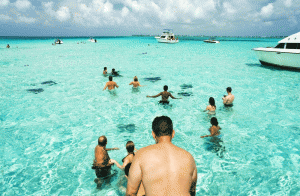
Columbus discovered Little Cayman and Cayman Brac during his fourth and last voyage to the New World, on May 10, 1503. While sailing from Panama to Hispaniola, severe winds pushed his ships off course west. The ship's log reported "... we were in sight of two very small islands, full of tortoise, as was the sea about, inasmuch as they looked like little rocks." Consequently, Columbus named the islands Las Tortugas after the abundant sea turtles sighted. The islands were later named Lagartos, meaning alligator or large lizard and finally, the name Caymanas was applied around 1540, derived from the Carib word for marine crocodile. This name in a modified form remained since the late 16th century.
They came under British control in 1655 when Jamaica was captured from the Spanish by Oliver Cromwell's army. They officially became part of the British Empire under the Treaty of Madrid in 1670, after which Spain recognized British possession of "all lands, islands, colonies and places situated in the West Indies." For almost 300 years after that, the islands were administered as a dependency of Jamaica.
Nestled in the calm, turquoise waters of the western Caribbean, lies the peaceful British Overseas Territory known as the Cayman Islands. Consisting of three islands just 480 miles south of Miami, Grand Cayman, Cayman Brac, and Little Cayman remain our little piece of paradise. Blessed with sun-kissed beaches and waters teeming with fish flecked with gold, the Cayman Islands offers some of the best diving and snorkeling in the world.
One of the many attractions Grand Cayman has to offer is Seven Mile Beach, a long stretch of white sand rated one of the most beautiful beaches in the entire Caribbean. Other attractions on Grand Cayman include the 65-acre Queen Elizabeth II Botanic Park and National Trust\'s Mastic Trail (2 mile traditional footpath through unspoiled woodlands in North Side); Cayman Islands National Museum in George Town; Pedro St. James Historic Site in Savannah; and Cardinal D\'s Park, a private collection of animals in a natural tropical park setting on Courts Rd; Cayman Turtle Farm; Hell; National Trust historic walking tours of central George Town and West Bay, blowholes in East End district and historic buildings now being restored under the direction of the National Trust and National Historic Sites Committee, including the Old Savannah Schoolhouse. Rum Point is not to be missed, imagine sipping a cocktail in a hammock on a beach, shaded by majestic Casuarina trees. Enjoy a beach snack or indulge in an a la carte meal or simply take a dip in the crystal clear sea. Reqular ferry services operate daily from the Hyatt Dock.
Activities and attractions
Golf - There are two golf courses in the Cayman Islands, both located on Grand Cayman. The Britannia Golf Course is a unique 18 hole executive with par 3's and 4's. On Mondays, Wednesdays, Fridays and Sunday mornings the course is played Executive format. Otherwise it is played as a very challenging 9 hole regulation course (twice for 18 if you so desire). The course is usually played with regular golf balls, however the Cayman Ball (that travels half the distance of a normal ball) was specially developed by course designer Jack Nicklaus with the executive course in mind to give golfers the feel of playing a regulation course on an executive layout. Some visitors like to try their hand at this very different experience! The Links at Safe Haven is a par 71, 18 hole championship layout, measuring 6,525 yards and featuring Caribbean trade winds in a natural setting reminiscent of an old Scottish links. Home to the Caribbean Amateur Championships in 1997, and winner of the 1998 Best Golf Course in the Caribbean Award by Caribbean World magazine, the Links is beautifully landscaped with native plants and trees, offering scenic views of the North Sound. Its North Sound signature hole, a par 3, hole number 11, is a humbling 235 yards from the tips played into strong Caribbean trade winds. Ample practice putting greens, bunkers and an aqua driving range complete this golf experience.
SCUBA - The Cayman Islands are consistently ranked as a top dive destination in the world. With an average water temperature of 82 degrees and visibility of 100 feet, the Cayman islands are a diver's paradise.
Shopping - What could be more exciting than spending a day shopping under a warm sun with a gentle breeze from the nearby ocean carrying you from shop to shop? Whether you are looking for dazzling jewellery, beautiful local arts and crafts or designer clothes, you will be pleased with the quality and selection our stores have to offer you. In Grand Cayman you never have to go far to shop. In addition to the shops in town, there are many small malls which have restaurants, liquor and gift shops including the new Grand Harbour Center.
Dining - More than 100 restaurants, fast-food outlets and small snack bars offer visitors a selection ranging from elegant fine dining to budget fast food and take out. Traditional Caymanian cuisine has been enlivened by a strong Jamaican influence of jerk, curry and other vibrant seasonings, and features conch, lobster and local seafood in a variety of dishes, complimented by coconut, plantain, breadfruit, yams, cassava, rice and peas and other West Indian side dishes.
In addition to Caribbean and Central American cuisine, Grand Cayman offers European, Italian, Mexican, German, Thai, Chinese, Indian, Japanese and "American Tex-Mex", as well as hamburgers, chicken, pizza, subs and salads.
Sting Ray City - A Stingray City snorkel trip in Grand Cayman will be the highlight of your vacation. Enjoy this unique experience of touching and feeding a Stingray, together with snorkeling amongst magnificent coral reefs and colorful tropical fish. The Stingray City Sandbar in Grand Cayman is lots of fun and suitable for everyone. Standing in only three feet of water you will be surrounded by more than two dozen friendly Stingrays.
